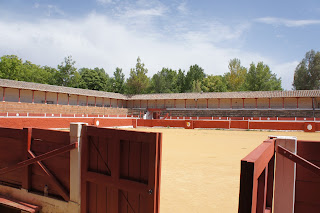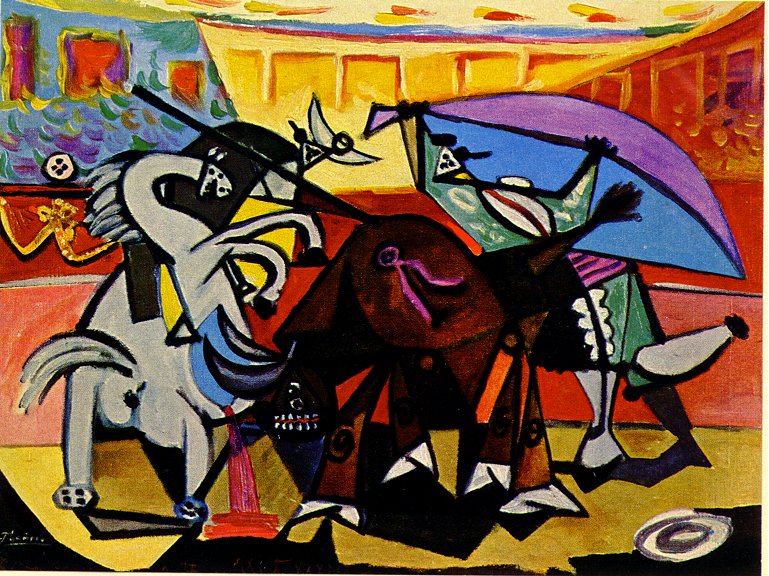 |
| Las Virtudes (near Santa Cruz de Mudela in Ciudad Real)
| |
|
 |
| Entrance to the Plaza |
After the visit to the windmills, our next stop was the Plaza de Toros (Bullfighting Ring) in Las Virtudes. Now, to get to Las Virtudes, you need to pass through Valdepenas, heading South from Consuegra. We did not stop here because we have family in the city and plan to return to spend several days with them there on a separate trip. However, I do not recommend passing by the many vineyards and this large city in La Mancha without trying some wine and eating some famous Manchego cheese. Unfortunately, I cannot make recommendations beyond that, but it is a great place to stop to spend the night if you have time. It will have good places to eat and bodegas (vineyards) to visit. This area of Spain produces a lot of wine and a lot of good wine. Most of the Spanish wines you find in the US are either from Valdepenas or Rioja. My husband and his family from here have told me many impressive numbers about production, varieties, export, etc. but I cannot remember them. Simply said, stop for the wine. Then head to this historic bull ring.
  |
| Plaza Cuadrada (opposed to the normal circular style) |
 |
| The plaza de toros- notice it's square |
The reason to go is that Santa Cruz de Mudela has one of the oldesnt bullfighting rings in Spain, the one in Las Virtudes (the virtues). It was constructed in 1645 and is the only one with a square form and is impressive. It is only technically open during certain hours to the public, similar to Spanish church hours- a few in the morning, 10-1 maybe, and some in the evening, 5-8 maybe. I am not sure what the exact hours are and I know that we were not there during open hours. However, they left the gates open and we were able to get inside. It seems like a small town, and the local bar is right at the entrance to the plaza, so they seem willing to keep it open for visitors beyond those hours. Try to look up the hours, but if you can't, stop by just in case they left it open for you.
 |
| To hide from the bulls! |
 |
| Very pretty with the bright red |
 |
| The viewing area |
 |
| the paths where the various participants enter, wait, watch, or occasionally hide during the bull fight |
 |
| Ole! |
 |
| Yep, that's me as a toro! |
While bullfighting is something that not all Spaniards love and that very few actually agree on, it is still very much a fabric of the history and culture of Spain. For example, Pablo Picasso was fascinated with bulls and matadors, and they show up in several of his sketches and paintings. When Hemingway lived in Spain, he was simply obsessed with the tradition. However, when I first arrived to Spain and met my future husband and told him I wanted to see a bullfight, I was met with...skepticism? criticism? confusion? I'm not sure how to describe it, but he simply did not understand why I would want to go to a bullfight. I asked if he had been to one, and he said yes. I said that was proof enough that I needed to go to one if I wanted to experience Spain and become Spanish. He shrugged, I suppose, and one of his friends later took me to one.

I admired the art of it. I could see why people would enjoy it. I understood the beauty that Hemingway described. He is right that "Bullfighting is the only art in which the
artist is in danger of death and in which the degree of brilliance in
the performance is left to the fighter's honor."


I could see the elegance and the dance so artistically captured in Picasso's paintings. The excitement in the arena was palpable; the crowd was intense. Their approval or disapproval was loud and extreme, and the crowd knew what was good and what was bad. They were all experts in Plaza de las Ventas in Madrid, and the Ole's were enthusiastic and well-timed. The Plaza itself was gorgeous.
But for all of that, it was bloody and disturbing. It did not help that is was a windy day, which meant more danger for the matadors and a messier death for the bulls. I particularly disliked the picadors, but I won't go into details in case anyone reading is squeamish. Besides, if you like the idea, then you simply must go and experience it yourself.
I never went to one again and doubt that I ever will. I understand what my husband meant all those years ago with his mixed reaction. It is part of Spain and it is Spanish, but bullfighting isn't really what it used to be. It was banned in the south of Spain, and many places no longer have them. But at one point, matadors were rock stars and bullfights were a huge part of culture in Spain, so seeing this historic bullring and visiting the one in Madrid is definitely worth your time. You do not need to actually see a bullfight- it is easy to tour the rings when there is no event going on.
And other than the sign you see at the entrance to the city, proclaiming to be another "lugar en la Mancha" and an outline of Don Quijote, there is no connection to the novel. So, I apologize for the digression, but since Don Quijote has become the symbol of Spain and is rooted in La Mancha, I think it can be excused.






















No comments:
Post a Comment